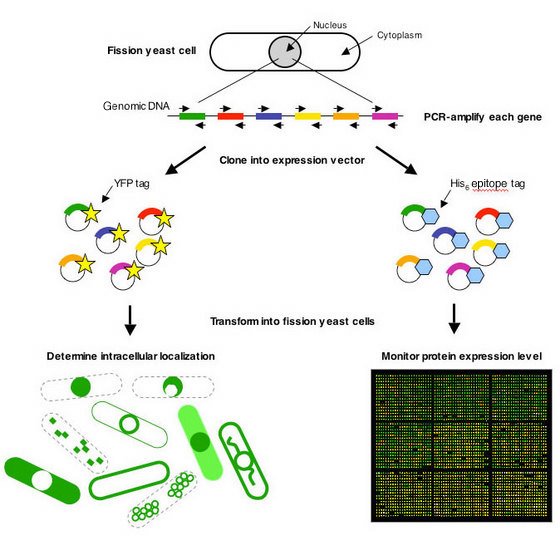Jul. 29, 2006 Research Highlight Biology Medicine / Disease
Connecting genes with proteins
New understanding of genes and the proteins for which they code could lead to identification of therapeutic drug targets
 Figure 1: A schematic diagram of how the team analyzed the connection between genes and proteins in fission yeast.
Figure 1: A schematic diagram of how the team analyzed the connection between genes and proteins in fission yeast.
A team led by researchers from RIKEN has cloned the DNA sequences responsible for all the nearly 5000 proteins produced in the cells of a particular strain of yeast.
The work provides a direct link between the complete set of genes—the genome—and the proteins for which it contains the plans—the proteome. Already, the team has been able to trace where about 90% of the proteins are utilized in the cell.
Genetic material consists of long chains of four different compounds, known as nucleotide bases. Parts of these sequences of bases code for the order of the amino acids which make up the proteins used to construct and operate living organisms. The genetic sequence is decoded by reading the bases in groups of three. But a correct outcome demands knowledge of exactly where each sequence starts and stops, and in which direction it is read. This is known as an open reading frame (ORF).
Led by Minoru Yoshida at the RIKEN Discovery Research Institute in Wako, the team employed a commercially available technique called recombination-based cloning to chop out, amplify and transfer all the predicted ORFs of the fission yeast, Schizosaccharomyces pombe, to expression vectors used to stimulate the production of their matching proteins in target cells.S. pombe has the smallest genome of all higher organisms and shares many traits with human cells.
After eliminating duplicate, partial and false genes, the team had close to 5000 cloned yeast ORFs. They then sequenced each ORF to check there were no serious errors.
As reported in Nature Biotechnology 1, by attaching a yellow fluorescent tag, the team tracked the protein produced from each ORF to where it was utilized (Fig. 1). Not only does this provide clues as to the protein’s role, but in many cases its function could also be compared with similar proteins in closely related yeasts and in other organisms. They also studied the function of a gene product which helps guide some of the proteins into position by pushing them out of the nucleus. Such transport factors often play an important role in disease, and can become useful targets for therapeutic drugs.
In the immediate future, the research team will continue the analysis of its yeast results, says Yoshida. “But we will also utilize our clones to produce drug sensitivity data and to identify drug targets. Based on our results, we have already started a new project developing a screening system for therapeutic drugs.”
References
- 1. Matsuyama, A., Arai, R., Yashiroda, Y., Shirai, A., Kamata, A., Sekido, S., Kobayashi, Y., Hashimoto, A., Hamamoto, M., Hiraoka, Y., Horinouchi, S. & Yoshida, M. ORFeome cloning and global analysis of protein localization in the fission yeast Schizosaccharomyces pombe. Nature Biotechnology 24, 841–847 (2006). doi: 10.1038/nbt1222
